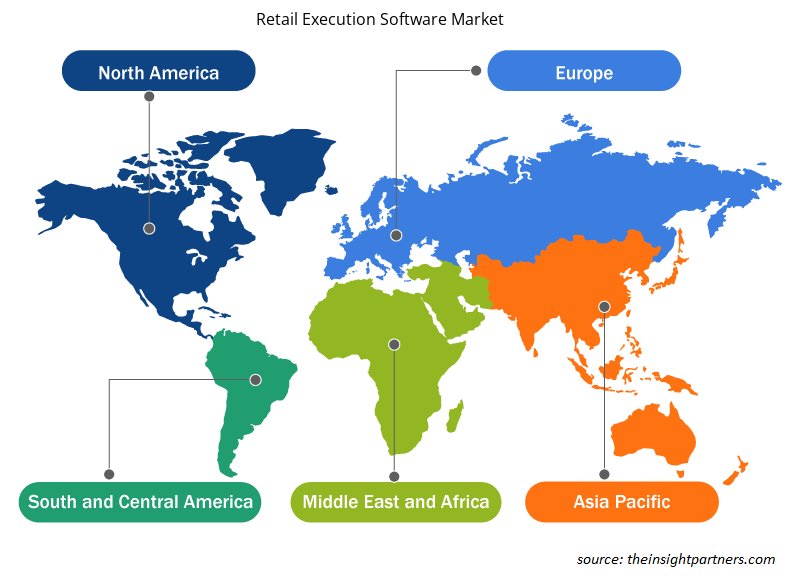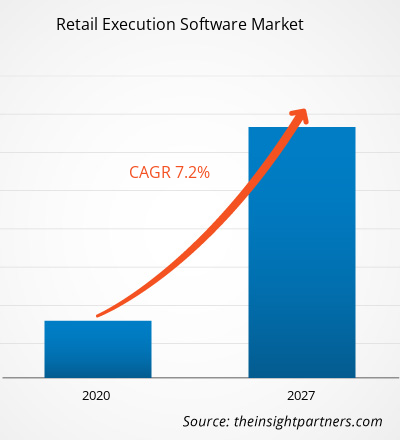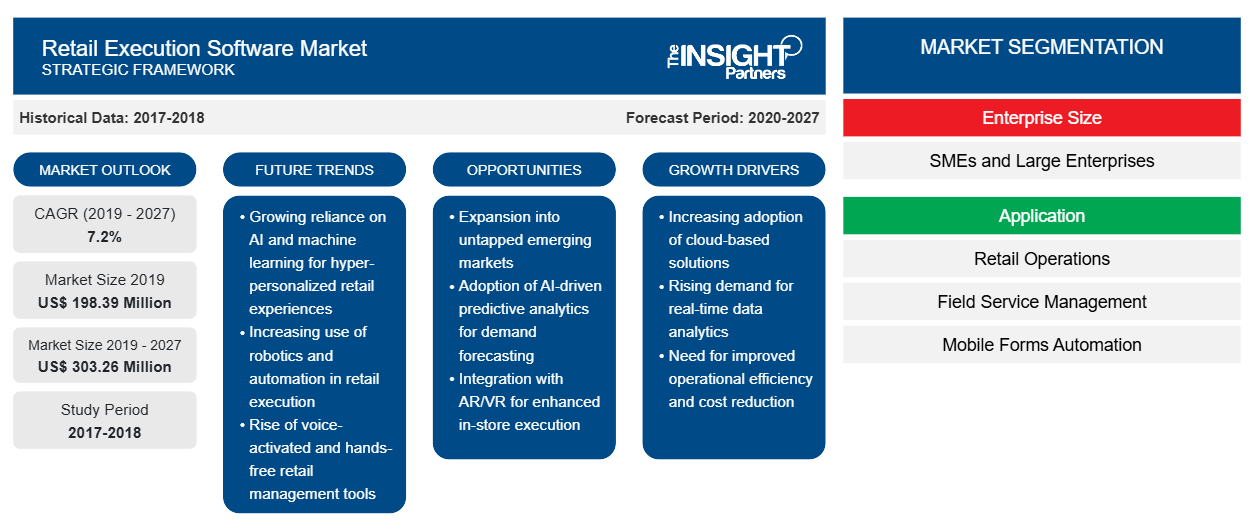Der Markt für Retail Execution-Software wurde im Jahr 2019 auf 198,39 Millionen US-Dollar geschätzt und soll bis 2027 einen Wert von 303,26 Millionen US-Dollar erreichen; von 2020 bis 2027 dürfte er mit einer durchschnittlichen jährlichen Wachstumsrate von 7,2 % wachsen.
Der globale Markt für Einzelhandelsabwicklungssoftware verzeichnet ein beträchtliches Wachstum aufgrund der wachsenden Präferenz für Einzelhandels- und E-Commerce-Plattformen und der zunehmenden Integration von Zahlungsgateways in Einzelhandelsabwicklungssoftware. Geografisch betrachtet war Nordamerika mit einem Umsatzanteil von 31,13 % Marktführer, gefolgt von Europa und APAC. Die Präsenz einer schnell wachsenden Wirtschaft, die zunehmende Einführung automatisierter Technologie, die zunehmende Verbreitung des Internets und die enorme Akzeptanz von Software durch Endbenutzer gehören zu den Hauptfaktoren, die das Wachstum des Marktes für Einzelhandelsabwicklungssoftware in diesen Regionen vorantreiben dürften. Der Markt für Einzelhandelsabwicklungssoftware in APAC wird im Prognosezeitraum voraussichtlich mit der höchsten durchschnittlichen jährlichen Wachstumsrate wachsen. Die zunehmende Einführung fortschrittlicher Technologien im Einzelhandel treibt die Einführungsrate von Einzelhandelsabwicklungssoftware voran. Unternehmen investieren in Software, um ihre Geschäftsabläufe zu rationalisieren. In APAC sind Indien und China die am schnellsten wachsenden Märkte für Einzelhandel und E-Commerce. Die Verbraucher dieser Länder neigen aufgrund der zunehmenden Internetdurchdringung stark zum Online-Shopping, und Online-Shopping-Trends verändern mehrere Bereiche des Einzelhandels und E-Commerce in der Region. Diese Faktoren treiben also das Wachstum des Marktes für Retail Execution Software in der Region Asien-Pazifik voran. Auch andere Entwicklungsregionen wie der Nahe Osten und Afrika (MEA) und Südsudan (SAM) werden voraussichtlich aufgrund der zunehmenden staatlichen Initiativen zur Digitalisierung der Wirtschaft durch den Einsatz fortschrittlicher Technologien stetig wachsen.
Passen Sie diesen Bericht Ihren Anforderungen an
Sie erhalten kostenlos individuelle Anpassungen an jedem Bericht, einschließlich Teilen dieses Berichts oder einer Analyse auf Länderebene, eines Excel-Datenpakets sowie tolle Angebote und Rabatte für Start-ups und Universitäten.
-
Holen Sie sich die wichtigsten Markttrends aus diesem Bericht.Dieses KOSTENLOSE Beispiel umfasst eine Datenanalyse von Markttrends bis hin zu Schätzungen und Prognosen.
Auswirkungen der COVID-19-Pandemie auf den Markt für Retail Execution Software
Laut dem jüngsten Bericht der Weltgesundheitsorganisation (WHO) gehören die USA, Spanien, Italien, Frankreich, Deutschland, Großbritannien, Russland, die Türkei, Brasilien, der Iran und China zu den am schlimmsten vom COVID-19-Ausbruch betroffenen Ländern. Die Krise wirkt sich weltweit negativ auf die Industrie aus. Die Weltwirtschaft wurde 2020 am stärksten getroffen, und dieser Zustand wird sich voraussichtlich auch 2021 fortsetzen. Der Ausbruch hat zu erheblichen Störungen in Schlüsselindustrien wie Logistik, Einzelhandel und E-Commerce geführt. Der starke Rückgang der internationalen Logistikbranche bremst das Wachstum des globalen Marktes für Einzelhandelsabwicklungssoftware.
Markteinblicke in die Retail Execution Software
Zunehmende Integration von Zahlungsgateways in Einzelhandelsabwicklungssoftware
Treibt das Wachstum des Marktes für Retail Execution Software voran
Online-Zahlungen sind in der Region Asien-Pazifik relativ beliebt, da die meisten Verbraucher ihre Waren mit dem Handy bezahlen. In Ländern wie Südkorea, Japan, Singapur und Australien werden mehrere beliebte E-Payment-Optionen für mobile digitale Einkäufe verwendet. Zahlungsgateway-Unternehmen in diesen Ländern bieten verschiedenen Anbietern von Einzelhandelssoftware umfassende E-Payment-Lösungen an, um auf der Welle der technologischen Entwicklung mitzureiten. Darüber hinaus ist das Marktwachstum auf Fortschritte in der Zahlungsgateway-Technologie und die zunehmende Nutzung mobiler Geldbörsen zurückzuführen. Die zunehmende Integration von Zahlungsgateway-Systemen mit Einzelhandelssoftware und der zunehmende Online-Einkauf sowie Fortschritte bei den Abrechnungsmethoden werden die Nachfrage nach Einzelhandelssoftware im Prognosezeitraum voraussichtlich weiter ankurbeln.
Markteinblicke basierend auf der Unternehmensgröße
Basierend auf der Unternehmensgröße ist der Markt für Einzelhandelsabwicklungssoftware in Großunternehmen und KMU unterteilt. Im Jahr 2019 hatte das Segment der Großunternehmen einen erheblichen Marktanteil. Es wird jedoch erwartet, dass das KMU-Segment im Prognosezeitraum eine erhebliche durchschnittliche jährliche Wachstumsrate verzeichnet.
Anwendungsbasierte Markteinblicke
Basierend auf der Anwendung ist der Markt für Einzelhandels-Execution-Software in Einzelhandelsbetrieb, Außendienstmanagement, Automatisierung mobiler Formulare, Außendienst, Handelsförderungsmanagement, Mitarbeiterbindung und andere unterteilt. Im Jahr 2019 hatte das Segment Einzelhandelsbetrieb einen erheblichen Marktanteil. Der Einzelhandelsbetrieb umfasst die Verwaltung von Einzelpersonen, Lieferketten, Ladenlayout, Bargeldbetrieb, physischem Inventar und die Verwaltung von Stammdaten, Werbeaktionen und Preisen. Einzelhandels-Execution-Software für den Einzelhandelsbetrieb stattet stationäre Einzelhandelsgeschäfte mit Tools aus, um ihre aktuellen Informationen zu nutzen und sie auf eine Weise einzusetzen, die ihrem Geschäft zugute kommt.
Unternehmen sind stark in der Entwicklung neuer Produkte engagiert, um auf dem Markt für Einzelhandels-Execution-Software Fuß zu fassen. Salesforce hat beispielsweise ein neues Branchenprodukt auf den Markt gebracht, nämlich Consumer Goods Cloud, mit dem Konsumgüterunternehmen ihr Umsatzwachstum steigern und ihren ROI durch verbesserte Einzelhandels-Execution-Funktionen erhöhen können. Nachfolgend sind einige Entwicklungen der wichtigsten Akteure aufgeführt:
2020: StayinFront, Inc. Retail Data Insight (RDI) hat seine Partnerschaft mit Field Sales Solutions für Echtzeitanalysen erweitert. Die Feldansicht und ROI-Ansicht von StayinFront RDI bieten Außendienstteams umsetzbare Erkenntnisse. Die Dienste erleichtern und maximieren die Effektivität im Geschäft und ermöglichen es den Kunden von Field Sales Solutions, mehr zu tun, mehr zu wissen und mehr zu verkaufen.
2018: Intelligence Retail wandte sich an IBM, um sein Hauptangebot zu verbessern und seinen Kunden die Möglichkeit zu geben, die wichtigsten Indikatoren für Filialprüfungen in Echtzeit zu verfolgen. Ein neues Analysemodul der Intelligence Retail-Lösung, das auf den eingebetteten IBM Watson Analytics-Technologien basiert, soll dabei helfen, die wichtigsten Indikatoren der Einzelhandelsprüfung effektiv zu verfolgen, indem Big Data in Echtzeit verarbeitet wird, darunter die Verfügbarkeit von Waren im Regal, Regalanteil, Preise und Werbeaktionen
Regionale Einblicke in den Markt für Retail Execution Software
Die regionalen Trends und Faktoren, die den Markt für Retail Execution Software im Prognosezeitraum beeinflussen, wurden von den Analysten von Insight Partners ausführlich erläutert. In diesem Abschnitt werden auch die Marktsegmente und die Geografie von Retail Execution Software in Nordamerika, Europa, im asiatisch-pazifischen Raum, im Nahen Osten und Afrika sowie in Süd- und Mittelamerika erörtert.

- Erhalten Sie regionale Daten zum Markt für Retail Execution Software
Umfang des Marktberichts zur Retail Execution Software
| Berichtsattribut | Details |
|---|---|
| Marktgröße im Jahr 2019 | 198,39 Millionen US-Dollar |
| Marktgröße bis 2027 | 303,26 Millionen US-Dollar |
| Globale CAGR (2019 - 2027) | 7,2 % |
| Historische Daten | 2017-2018 |
| Prognosezeitraum | 2020–2027 |
| Abgedeckte Segmente |
Nach Unternehmensgröße
|
| Abgedeckte Regionen und Länder |
Nordamerika
|
| Marktführer und wichtige Unternehmensprofile |
|
Dichte der Marktteilnehmer für Retail Execution Software: Deren Auswirkungen auf die Geschäftsdynamik
Der Markt für Retail Execution Software wächst rasant, angetrieben durch die steigende Nachfrage der Endnutzer aufgrund von Faktoren wie sich entwickelnden Verbraucherpräferenzen, technologischen Fortschritten und einem größeren Bewusstsein für die Vorteile des Produkts. Mit steigender Nachfrage erweitern Unternehmen ihr Angebot, entwickeln Innovationen, um die Bedürfnisse der Verbraucher zu erfüllen, und nutzen neue Trends, was das Marktwachstum weiter ankurbelt.
Die Marktteilnehmerdichte bezieht sich auf die Verteilung von Firmen oder Unternehmen, die in einem bestimmten Markt oder einer bestimmten Branche tätig sind. Sie gibt an, wie viele Wettbewerber (Marktteilnehmer) in einem bestimmten Marktraum im Verhältnis zu seiner Größe oder seinem gesamten Marktwert präsent sind.
Die wichtigsten Unternehmen auf dem Markt für Retail Execution Software sind:
- Bizom (Mobisy Technologies Private Limited)
- EdgeCG (StayinFront, Inc.),
- Intelligenz Einzelhandel
- Mobisoft
- POPProbe
Haftungsausschluss : Die oben aufgeführten Unternehmen sind nicht in einer bestimmten Reihenfolge aufgeführt.

- Überblick über die wichtigsten Akteure auf dem Markt für Retail Execution Software
Nach Unternehmensgröße
- Große Unternehmen
- KMU
Nach Anwendung
- Einzelhandelsgeschäfte
- Außendienstmanagement
- Automatisierung mobiler Formulare
- Außendienst
- Handelsförderungsmanagement
- Mitarbeiterengagement
- Sonstiges
Nach Geografie
-
Nordamerika
- UNS
- Kanada
- Mexiko
-
Europa
- Frankreich
- Deutschland
- Italien
- Vereinigtes Königreich
- Russland
- Restliches Europa
-
Asien-Pazifik (APAC)
- China
- Indien
- Südkorea
- Japan
- Australien
- Restlicher Asien-Pazifik-Raum
-
Naher Osten und Afrika (MEA)
- Südafrika
- Saudi-Arabien
- Vereinigte Arabische Emirate
- Rest von MEA
-
Südamerika (SAM)
- Brasilien
- Argentinien
- Rest von SAM
Firmenprofile
- Bizom (Mobisy Technologies Private Limited)
- EdgeCG (StayinFront, Inc.)
- Intelligenz Einzelhandel
- Mobisoft
- POPProbe
- Spring Mobile Solutions, Inc.
- Trax Technology Solutions Pte Ltd.
- Valomnia
- GEWINNEN
- Kantar-Gruppe
- Historische Analyse (2 Jahre), Basisjahr, Prognose (7 Jahre) mit CAGR
- PEST- und SWOT-Analyse
- Marktgröße Wert/Volumen – Global, Regional, Land
- Branchen- und Wettbewerbslandschaft
- Excel-Datensatz
Aktuelle Berichte
Verwandte Berichte
Erfahrungsberichte
Grund zum Kauf
- Fundierte Entscheidungsfindung
- Marktdynamik verstehen
- Wettbewerbsanalyse
- Kundeneinblicke
- Marktprognosen
- Risikominimierung
- Strategische Planung
- Investitionsbegründung
- Identifizierung neuer Märkte
- Verbesserung von Marketingstrategien
- Steigerung der Betriebseffizienz
- Anpassung an regulatorische Trends























 Kostenlose Probe anfordern für - Markt für Retail-Execution-Software
Kostenlose Probe anfordern für - Markt für Retail-Execution-Software